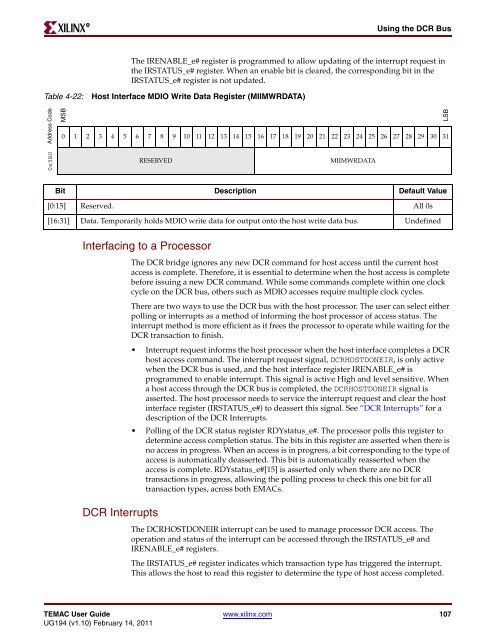Xilinx UG194 Virtex-5 FPGA Embedded Tri-Mode Ethernet MAC ...
Xilinx UG194 Virtex-5 FPGA Embedded Tri-Mode Ethernet MAC ...
Xilinx UG194 Virtex-5 FPGA Embedded Tri-Mode Ethernet MAC ...
Create successful ePaper yourself
Turn your PDF publications into a flip-book with our unique Google optimized e-Paper software.
R<br />
Using the DCR Bus<br />
The IRENABLE_e# register is programmed to allow updating of the interrupt request in<br />
the IRSTATUS_e# register. When an enable bit is cleared, the corresponding bit in the<br />
IRSTATUS_e# register is not updated.<br />
Table 4-22: Host Interface MDIO Write Data Register (MIIMWRDATA)<br />
Address Code<br />
0x3B0<br />
MSB<br />
0 1 2 3 4 5 6 7 8 9 10 11 12 13 14 15 16 17 18 19 20 21 22 23 24 25 26 27 28 29 30 31<br />
Interfacing to a Processor<br />
DCR Interrupts<br />
RESERVED MIIMWRDATA<br />
Bit Description Default Value<br />
[0:15] Reserved. All 0s<br />
[16:31] Data. Temporarily holds MDIO write data for output onto the host write data bus. Undefined<br />
The DCR bridge ignores any new DCR command for host access until the current host<br />
access is complete. Therefore, it is essential to determine when the host access is complete<br />
before issuing a new DCR command. While some commands complete within one clock<br />
cycle on the DCR bus, others such as MDIO accesses require multiple clock cycles.<br />
There are two ways to use the DCR bus with the host processor. The user can select either<br />
polling or interrupts as a method of informing the host processor of access status. The<br />
interrupt method is more efficient as it frees the processor to operate while waiting for the<br />
DCR transaction to finish.<br />
Interrupt request informs the host processor when the host interface completes a DCR<br />
host access command. The interrupt request signal, DCRHOSTDONEIR, is only active<br />
when the DCR bus is used, and the host interface register IRENABLE_e# is<br />
programmed to enable interrupt. This signal is active High and level sensitive. When<br />
a host access through the DCR bus is completed, the DCRHOSTDONEIR signal is<br />
asserted. The host processor needs to service the interrupt request and clear the host<br />
interface register (IRSTATUS_e#) to deassert this signal. See “DCR Interrupts” for a<br />
description of the DCR Interrupts.<br />
Polling of the DCR status register RDYstatus_e#. The processor polls this register to<br />
determine access completion status. The bits in this register are asserted when there is<br />
no access in progress. When an access is in progress, a bit corresponding to the type of<br />
access is automatically deasserted. This bit is automatically reasserted when the<br />
access is complete. RDYstatus_e#[15] is asserted only when there are no DCR<br />
transactions in progress, allowing the polling process to check this one bit for all<br />
transaction types, across both E<strong>MAC</strong>s.<br />
The DCRHOSTDONEIR interrupt can be used to manage processor DCR access. The<br />
operation and status of the interrupt can be accessed through the IRSTATUS_e# and<br />
IRENABLE_e# registers.<br />
The IRSTATUS_e# register indicates which transaction type has triggered the interrupt.<br />
This allows the host to read this register to determine the type of host access completed.<br />
TE<strong>MAC</strong> User Guide www.xilinx.com 107<br />
<strong>UG194</strong> (v1.10) February 14, 2011<br />
LSB

















